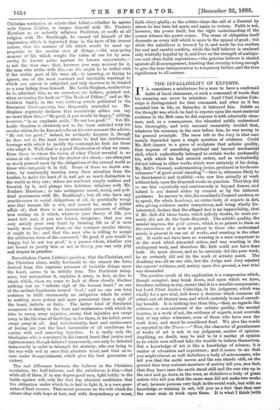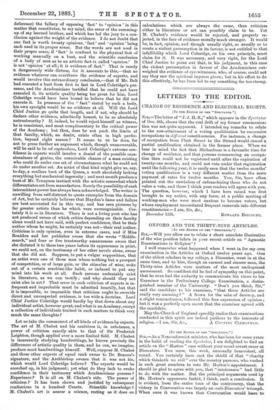THE INFALLIBILITY OF EXPERTS.
IT is sometimes a misfortune for a man to have a confirmed habit of lucid statement, or such a command of words that his meaning can never be mistaken. Lord Chief Justice Cole-
ridge is distinguished for that command, and often as it has assisted him in life, on Saturday it betrayed him. Subtle as
the thought was which he had to express upon the most material evidence in the Belt case, he did express it with admirable clear- ness, and, as a consequence, the educated public understood him thoroughly, and with unusual unanimity decided that, -whatever his accuracy in the case before him, he was wrong in his general principle. The issue left to the Jury in that case mainly depended upon a single question of evidence. Could Mr. Belt impart to a piece of sculpture that artistic quality, that impress of something spiritual and beyond mechanical skill, which undoubtedly belonged to certain works professedly his, with which he had secured orders, and as undoubtedly did not belong to other works which were certainly of his doing. Mr. Belt's Counsel, understanding juries, produced in his favour witnesses" of good social standing "—that is, witnesses likely to be disinterested and truthful—who saw him actually at work without help upon the disputed works in question. That they did so see him repeatedly and continuously is beyond demur, and indeed is not denied either by counsel or by the bitterest partisans. In answer to this, his assailant's Counsel produce, so to speak, the whole Academy, an entire body of experts in Art, who, giving evidence under compulsion, and being wholly dis- interested, declare that the alleged fact is an impossibility, that if Mr. Belt did those busts, which nobody doubts, he most cer- tainly did not do the busts disputed. The artistic quality, the mental impress, the quid minor', which is as patent to them as the correctness of a note is patent to those who understand music, is present in one set of works, and wanting in the other set. It could not have been so wanting in a man competent to do the work which attracted orders, and was wanting in the undisputed work, and therefore Mr. Belt could not have done both. He must choose, and as he certainly did the-poor work, he as certainly did not do the work of artistic merit. The Academy was all on one side, but the Judge and Jury rejected the experts' evidence, and, mainly upon this ground, a new trial was demanded.
The positive result of the application is a compromise which, though accepted, may break down, and upon which we have, therefore, nothing to say, except that it is a sensible compromise ; but Lord Chief Justice Coleridge, in his judgment, which was wholly for a new trial, laid down a doctrine which concerns all artists and all literary men, and which certainly is one of exceed- ing breadth. It is nothing less than this,—that, as regards the existence or non-existence Of the artistic quality, the mental impress, in a work of art, the evidence of experts must override that of any other witnesses, even of those who have seen the work done, and must be considered final. We give the words as reported in the Times :—" Now, the character of genuineness of works of art is not, in my judgment, matter of opinion. Anything, no doubt, may be said to be a matter of opinion as to which men will not take the trouble to inform themselves. But a knowledge of art is like a knowledge of science; it is matter of education and experience ; and it seems to me that you might almost as well disbelieve a body of astronomers, who tell you that the earth moves and the sun stands still, on the ground that very eminent members of society tell you, aim fact, that they have seen the earth stand still and the sun rise up in the east and go down in the west, as disbelieve a body of great artists who tell you that the same man did not make two works of art, because persons very high in the social scale, but with no knowledge or training in art, tall you as a fact that they-saw the same man at work upon them. It is what I think (with deference) the fallacy of opposing ' fact ' to opinion ' in this matter that constitutes, to my mind, the error of the summing- up of my learned brother, and which has led the jury to a con- clusion against the weight of the evidence. I do not doubt that one fact is worth twenty opinions, 'fact' and opinion 'being each used in its proper sense. But the words are not used in their proper sense, if 'fact' is confined to the physical fact of working manually on a bust, and the scientific conclusion of a body of men as to an artistic fact is called • opinion.' It is not 'opinion' at all; it is evidence of fact." That is surely a dangerously wide dictum, for it amounts to this,—that no evidence whatever can overthrow the evidence of experts, and would involve this extraordinary conclusion,—that if Mr. Belt had executed a bust from first to last in Lord Coleridge's pre- sence, and the Academicians testified that he could not have executed it, its artistic quality being too great for him, Lord Coleridge would have been bound to believe that he did not execute it. In presence of the "fact" stated by such a body, his own eyesight would be no evidence at all. Will the Lord Chief Justice go quite that length, and if not, why should he declare other evidence, admittedly honest, to be so absolutely untrustworthy ? If, indeed, he would reject himself as witness, he is consistent, and most complimentary to the critical power of the Academy; but then, does he not push the limits of that faculty, which, no doubt, exists often in high perfec- tion, beyond right reason ? It seems to us he does, for not to press further an argument which, though unanswerable, will be said to be ad captandum, Lord Coleridge's extreme con- fidence in experts would involve a denial of the possible occa- sionalness of genius, the conceivable chance of a man existing who could do under one set of circumstances what he could not do under another set. An artist of that kind might give us, say, to-day, a soulless bust of the Queen, a work absolutely lacking everything but mechanical ingenuity ; and next month produce a bust of Mr. Tennyson instinct with the artistic somewhat which
differentiates art from manufacture. Surely the possibility of such intermittent power has always been acknowledged. The writer is
unwilling from self-distrust to quote examples from the domain of Art, but he certainly believes that Haydon's fame and failure are best accounted for in this way, and has seen pictures by far greater artists than he which were unrecognisable. Cer- tainly it is so in literature. There is not a living poet who has not produced verses of which critics depending on their faculty alone would not have said, with perfect confidence, that be their author whom he might, he certainly was not—their real author. Criticism is only opinion, even in extreme cases, and if Miss Braddon and her publisher swore that she wrote "Middle- march," and four or five trustworthy amanuenses swore that she dictated it to them two years before its appearance in print, we could not, on the testimony of her other novels alone, swear that she did not. Suppose, to put a vulgar supposition, that an artist were one of those men whom nothing but a prospect of competition, or of large gain, or the stimulus of wine, woke out of a certain machine-like habit, or induced to put any mind into his work at all. Such persons undeniably exist in literature, as we can testify ; and why should they not exist also in art That error in such criticism of experts is in- frequent and improbable must be admitted heartily, but that it is impossible, so impossible that criticism ought to override direct and unsuspected evidence, is too wide a doctrine. Lord Chief Justice Coleridge would hardly lay that down about any individual artist, however great, and what is an Academy, except a collection of individuals trained in such matters to think very much the same thoughts?
Let us take the commonest of all kinds of evidence by experts. The art of M. Chabot and his confreres is, in substance, a power of criticism exactly akin to that of Sir Frederick Leighton, though applied over a more limited field. M. Chabot is incessantly studying handwritings, he knows precisely the differences of artistic quality in them, and he can, we imagine, produce most handwritings himself. Well, suppose M. Chabot and three other experts of equal rank swear to Dr. Benson's signature, and the Archbishop swears that it was not his, which would Lord Coleridge believe ? The experts would be scorched up, in his judgment; yet what do they lack to evoke confidence in their testimony which Academicians possess ? Experience? It is all on M. Chabot's side. The power of criticism ? ' It has been shown and justified by subsequent confessions in a: hundred Courts. Scientific knowledge M. Chabot's art is nearer a science, resting as it- does on
calculations which are always the same, than criticism either in literature or art can possibly claim to be. Yet M. Chabot's evidence would be rejected, and properly re- jected, in the face of evidence morally much stronger. It would be, in fact, opinion, and though usually right, so usually as to create a violent presumption in its favour, is not entitled to that infallibility which Lord Coleridge, on his own principle, must claim for it. It was necessary, and very right, for the Lord Chief Justice to point out that, in his judgment, in this case• the violent presumption in favour of the Academicians out- weighed the evidence of eye-witnesses, who, of course, could not say they saw the spiritual impress given ; but in his effort to do this effectively, he has been led to say something far too strong.







































 Previous page
Previous page